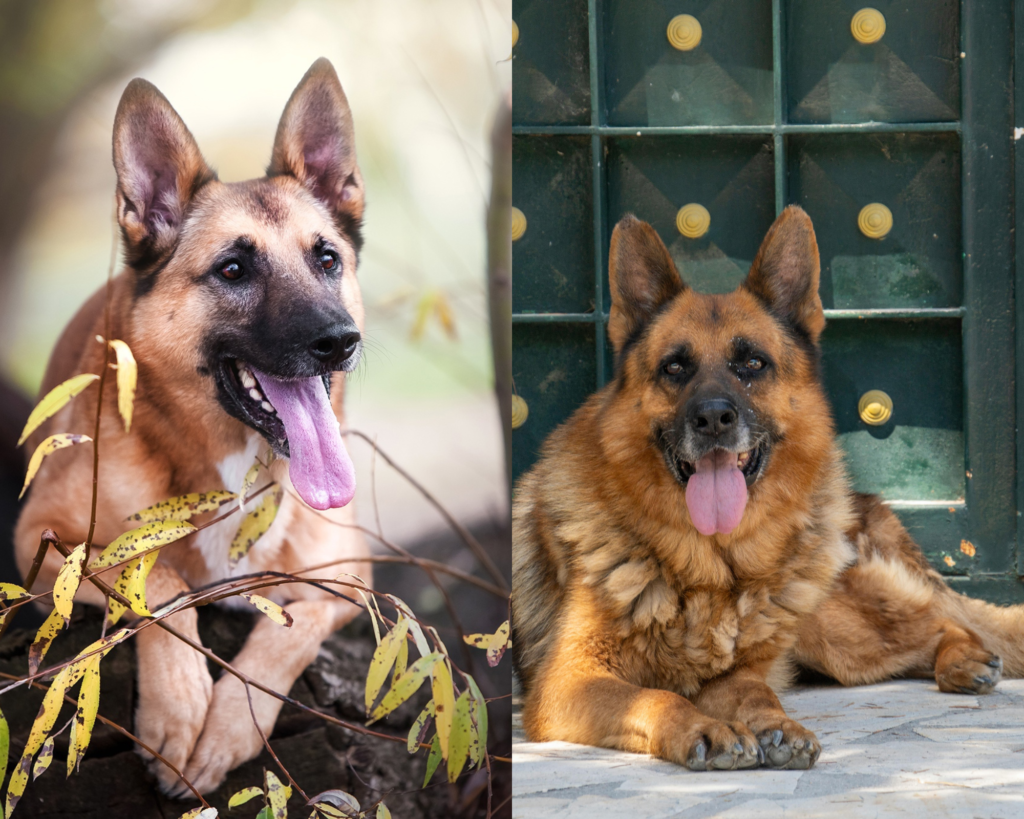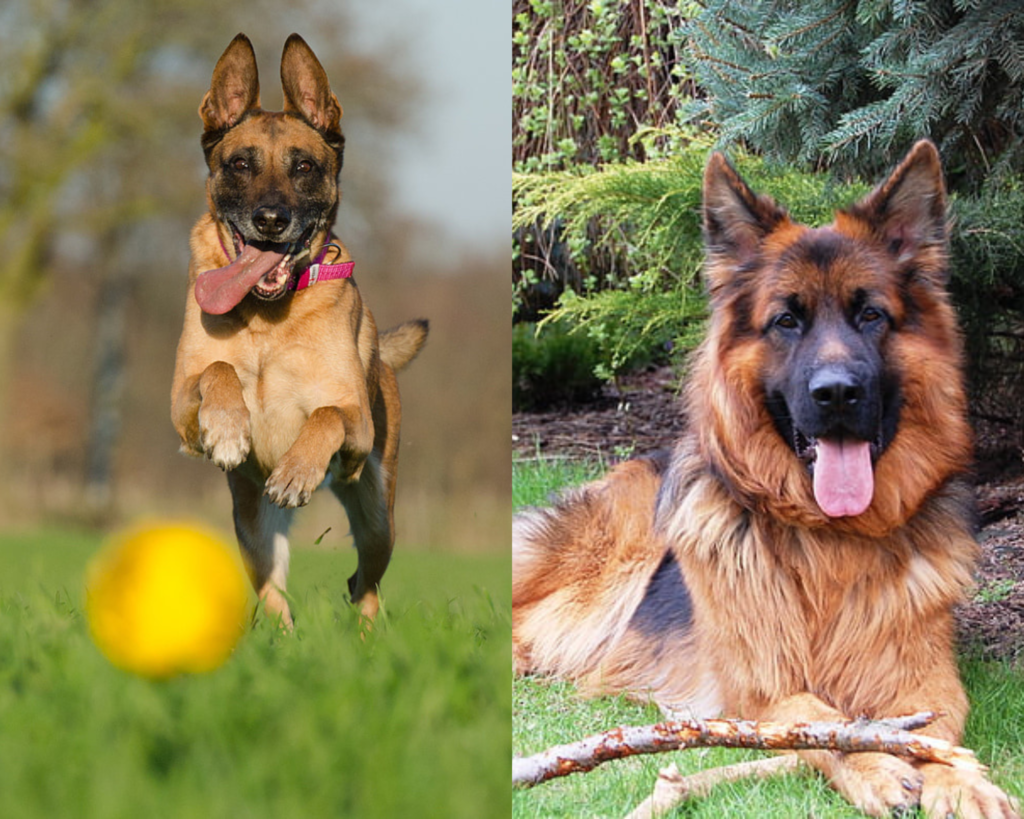
So, you’re trying to decide between a Belgian Malinois and a German Shepherd, huh? It’s not an easy choice. Both breeds have their own unique traits, and they can be great companions if you know what you’re getting into. Whether you’re looking for a family dog, a working buddy, or just a loyal friend, there’s a lot to consider. Let’s break it down and see what makes each breed tick.
Key Takeaways
- The German Shepherd was developed in Germany in the late 1800s, while the Belgian Malinois originated in Belgium around the same time.
- German Shepherds tend to be larger and more robust, while Belgian Malinois are often leaner and more agile.
- Both breeds are highly intelligent and trainable, but Belgian Malinois may have higher energy levels and require more mental stimulation.
- German Shepherds are generally more family-oriented and protective, making them great for households with kids.
- Both breeds have specific health and dietary needs, with German Shepherds prone to hip dysplasia and Belgian Malinois potentially facing eye issues.
Breed Origins and History
Development of the German Shepherd
The German Shepherd, a breed synonymous with loyalty and intelligence, traces its roots back to the late 19th century in Germany. It was developed by Captain Max von Stephanitz, who aimed to create the ideal working dog. By crossbreeding various herding dogs, he focused on producing a breed that excelled in both strength and intelligence. The result was a dog that not only served as a herder but also as a protector. Over time, the German Shepherd’s role expanded beyond farming into police and military work, thanks to its versatility and trainability.
Origins of the Belgian Malinois
The Belgian Malinois, part of the Belgian Shepherd family, originated in the Malines region of Belgium. Known for its agility and keen sense of smell, this breed was initially used for herding livestock. Unlike the German Shepherd, the Malinois was bred more for its working ability than for specific physical traits. Its history is deeply tied to the Belgian countryside, where it was valued for its quick reflexes and sharp instincts. As time passed, the Malinois gained recognition for its skills in police and military operations, much like its German counterpart.
Herding Heritage of Both Breeds
Both the German Shepherd and the Belgian Malinois share a rich herding heritage. These breeds were initially developed to assist farmers in managing livestock, a task that required intelligence, strength, and agility. Their roles in herding laid the foundation for their future as working dogs in various sectors. While the German Shepherd was tailored for versatility, the Malinois was honed for its speed and precision. This shared background highlights their adaptability and the reason why they continue to be favored in demanding roles today.
The history of these breeds is a testament to their enduring appeal and functionality. From humble herding origins to modern-day service dogs, their journey reflects a blend of tradition and evolution.
Physical Characteristics and Appearance
Size and Weight Differences
When it comes to size, both the Belgian Malinois and the German Shepherd stand tall, but there are some differences. Males of both breeds typically range from 24 to 26 inches in height, while females are slightly shorter, standing between 22 to 24 inches. However, the weight is where they diverge. Belgian Malinois tend to be lighter, with males weighing between 60 to 80 pounds and females from 40 to 60 pounds. In contrast, male German Shepherds can tip the scale at up to 90 pounds, with females weighing up to 70 pounds. If you’re considering which breed might be easier to lift or manage, the lighter Belgian Malinois might be a better fit.

Coat and Color Variations
Both breeds boast beautiful coats, but their colors and textures set them apart. The German Shepherd is often recognized for its classic tan and black two-tone coat, which can sometimes appear more black than tan. On the other hand, the Belgian Malinois is predominantly tan, offering a more solid color look. Both breeds do shed, but be prepared—the German Shepherd might leave a bit more fur around your home.
Distinctive Features of Each Breed
Though they share some physical similarities, several features make each breed unique. The Belgian Malinois is known for its triangular ears and a more squared-off body shape, giving it a leaner appearance. In contrast, the German Shepherd has pointy ear tips and a muscular frame, often described as “longer than tall.” Their tails also differ, with the Malinois having an angled tail and the German Shepherd a more poofy one.
Both breeds are known for their intelligence and versatility, often excelling in roles such as police and service dogs. Despite their similar appearances, these distinctive features make them easy to differentiate when you know what to look for.
Temperament and Personality Traits
Energy Levels and Exercise Needs
Both the Belgian Malinois and the German Shepherd are high-energy breeds that thrive on regular physical activity. If you’re someone who enjoys outdoor adventures, these dogs might just be your perfect companions. They need daily exercise to keep their bodies and minds sharp. This isn’t just about taking them for a walk around the block; think more along the lines of running, hiking, or engaging in dog sports.
- Belgian Malinois: Known for their boundless energy, these dogs excel in agility and obedience training. They’re not the type to lounge around all day.
- German Shepherd: While also energetic, they tend to balance their activity with more relaxed downtime. They enjoy a variety of exercises, from running to participating in dog sports like herding and tracking.
Family Compatibility and Social Behavior
When it comes to family life, the German Shepherd often shines as the more family-oriented breed. They tend to bond with the entire family, making them great companions for households with kids. On the other hand, the Belgian Malinois usually picks a favorite person to bond with, which might not always suit a family setting.
- German Shepherd: Known for their affectionate nature, they are often described as “oversized lap dogs.” They usually do well with children and are protective of their family.
- Belgian Malinois: More reserved, they might not be as openly affectionate as German Shepherds. They require an owner who understands their unique social needs.
Protective Instincts and Loyalty
Both breeds are renowned for their protective instincts and loyalty. These traits make them exceptional watchdogs and protective companions. However, their loyalty can sometimes translate into overprotectiveness, which requires proper training and socialization.
- Belgian Malinois: They possess a strong protective instinct, often acting as vigilant guardians. Their loyalty is usually directed towards one person, making them excellent one-on-one companions.
- German Shepherd: Their loyalty extends to the whole family, making them reliable protectors. They are often seen as more affectionate and open, which can be a plus for families.
Owning either of these breeds requires commitment and understanding of their needs. Their energy, loyalty, and intelligence make them incredible companions, but they are not for everyone. If you’re ready for the challenge, these dogs will reward you with unmatched companionship and protection.

Both breeds are incredible in their own right, but it’s crucial to understand their differences, especially when considering them as family pets or working dogs. Whether you choose the more family-friendly German Shepherd or the focused and energetic Belgian Malinois, you’re in for a rewarding experience.
Training and Intelligence
Trainability and Obedience
When it comes to training, both Belgian Malinois and German Shepherds are at the top of their class. Their intelligence and eagerness to please make them highly trainable. These breeds thrive on structured training sessions, which help channel their energy and focus. However, it’s crucial to start training early, as both breeds can develop stubborn streaks if not properly guided. Consistency and positive reinforcement are key to instilling obedience in these dogs.
Mental Stimulation and Challenges
Both breeds require more than just physical exercise; they need mental challenges to stay happy and healthy. Think of activities like puzzle toys, advanced obedience training, or agility courses. These dogs are not just smart—they need to be mentally engaged. Without mental stimulation, they can become bored and potentially destructive. A simple walk around the block won’t cut it for these intelligent dogs.
Role in Police and Military Work
The Belgian Malinois and German Shepherd have carved out significant roles in police and military work. Their keen senses, loyalty, and ability to be trained in complex tasks make them invaluable in high-stakes situations. From sniffing out explosives to apprehending suspects, these dogs are on the front lines. Their versatility and work ethic are unmatched, making them the preferred choice for many K-9 units.
“These breeds are not just pets; they’re partners in crime-fighting and national security.”
Health and Dietary Needs
Common Health Issues
When it comes to health, both Belgian Malinois and German Shepherds have their share of concerns. German Shepherds often face problems like hip and elbow dysplasia. This can lead to discomfort and mobility issues as they age. Belgian Malinois, on the other hand, might experience progressive retinal atrophy which affects their vision. Bloat is another condition that both breeds are susceptible to. This is a serious issue where the stomach fills with gas and can twist, requiring immediate veterinary attention.
- Hip and Elbow Dysplasia: Common in German Shepherds, affecting joints.
- Progressive Retinal Atrophy: Affects vision in Belgian Malinois.
- Bloat: Affects deep-chested dogs like both breeds.
Nutritional Requirements
A balanced diet is crucial for these active and muscular breeds. They need high-quality proteins and fats to maintain their energy and muscle mass. Small, frequent meals are recommended to help prevent bloat. Always consult with a vet to tailor a diet plan specific to your dog’s needs.
- Proteins: Essential for muscle maintenance and energy.
- Fats: Important for overall health and energy.
- Meal Frequency: Smaller, more frequent meals can help prevent bloat.
Preventive Care and Regular Check-ups
Routine vet visits are key to catching potential health issues early. Regular check-ups can help monitor joint health, eye health, and overall well-being. Preventive care, like vaccinations and parasite control, should be maintained as per your vet’s guidance.
Keeping up with preventive care and regular vet check-ups ensures that your furry friend stays healthy and happy. Early detection of health issues can make a world of difference in treatment and quality of life.
Popularity and Cultural Impact
Media and Pop Culture Appearances
Both the Belgian Malinois and German Shepherd have made their mark in movies and TV shows. The German Shepherd, with its noble look, has been a favorite in classic films like “Rin Tin Tin.” This breed’s intelligence and trainability make it a natural choice for roles requiring complex tasks or emotions. On the other hand, the Belgian Malinois is gaining traction, thanks to its incredible agility and sharp focus. In action-packed scenes, this breed shines, often portraying military or police dogs.
Trends in Breed Popularity
Over the years, the demand for these breeds has shifted. The German Shepherd has long been a staple in homes and work environments due to its versatility. However, the Belgian Malinois is catching up. Its versatility and strong work ethic are drawing more attention, especially among those seeking a loyal and intelligent companion. This trend reflects a growing appreciation for breeds that can adapt to various roles, from family pets to working dogs.
Role in Society and Working Roles
German Shepherds have a well-established history in police and military work, known for their protective instincts and loyalty. They are often seen in K-9 units, search and rescue missions, and even as guide dogs. Meanwhile, the Belgian Malinois is increasingly recognized for similar roles. Its smaller size and agility give it an edge in certain tasks, making it a preferred choice in specific operations. The unique skills of both breeds ensure they remain integral to many societal roles.
The growing popularity of these breeds highlights their adaptability and the unique qualities they bring to various aspects of life. Whether in entertainment, as family pets, or in service roles, both the German Shepherd and Belgian Malinois continue to leave a significant mark on society.

Conclusion
So, there you have it. Whether you’re leaning towards the Belgian Malinois or the German Shepherd, both breeds have their own unique charm and set of skills. The Malinois is like that friend who’s always on the go, ready for the next adventure, while the German Shepherd is the reliable buddy who’s got your back no matter what. If you’re looking for a high-energy partner to keep up with your active lifestyle, the Malinois might just be your perfect match. But if you want a loyal family companion who’s great with kids and can double as a guard dog, the German Shepherd could be the way to go. At the end of the day, it all boils down to what fits best with your life and what you’re looking for in a furry friend. Whichever you choose, you’re in for a lot of love and a lot of fun.
Frequently Asked Questions
What are the key differences between a Belgian Malinois and a German Shepherd?
Belgian Malinois and German Shepherds are both herding breeds, but they have some differences. The Belgian Malinois is generally smaller and lighter, with a more square build, while the German Shepherd is larger and has a more robust body. They also differ in temperament, with Malinois being more energetic and focused, whereas German Shepherds are known for their calm and protective nature.
Which breed is better for families with children?
German Shepherds are often considered better family dogs because they are known for being gentle and protective with children. Belgian Malinois can also be good with kids but may require more training and socialization due to their high energy levels.
Are Belgian Malinois and German Shepherds easy to train?
Yes, both breeds are highly trainable due to their intelligence and eagerness to please. However, Belgian Malinois may require more mental stimulation and exercise to keep them engaged, while German Shepherds are known for their obedience and versatility in training.
What are common health issues for these breeds?
German Shepherds are prone to hip and elbow dysplasia, while Belgian Malinois may face eye problems like progressive retinal atrophy. Regular vet check-ups and a healthy lifestyle can help manage these issues.
Do these breeds require a lot of exercise?
Yes, both breeds are very active and need plenty of exercise. Belgian Malinois, in particular, have extremely high energy levels and require regular physical and mental activities to keep them happy. German Shepherds also enjoy being active and need daily exercise.
How do these breeds fare in police and military work?
Both breeds excel in police and military roles due to their intelligence, loyalty, and work ethic. Belgian Malinois are often favored for tasks requiring speed and agility, while German Shepherds are known for their strength and protective instincts.

